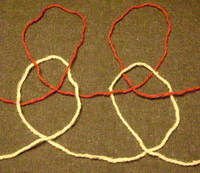.gif)
Plaited stitch (knitting)
Encyclopedia
In knitting
, a plaited stitch is a single knitted stitch that is twisted clockwise (right over left) or counterclockwise (left over right), usually by one half-turn (180°) but sometimes by a full turn (360°) or more.
 Plaited stitches can be produced in several ways. Knitting into the back loop produces a clockwise plaited stitch in the lower stitch being knitted (i.e., the loop that was on the left-hand needle.) The clockwise-plaited stitch is also called a left crossed stitch, since the left strand (i.e., the outgoing strand) of the loop crosses over the right incoming strand. Left-crossed stitches are sometimes called twisted stitches, although the latter term might be confused with similar terms from cable knitting
Plaited stitches can be produced in several ways. Knitting into the back loop produces a clockwise plaited stitch in the lower stitch being knitted (i.e., the loop that was on the left-hand needle.) The clockwise-plaited stitch is also called a left crossed stitch, since the left strand (i.e., the outgoing strand) of the loop crosses over the right incoming strand. Left-crossed stitches are sometimes called twisted stitches, although the latter term might be confused with similar terms from cable knitting
. Conversely, a counterclockwise plaited stitch can be produced if the yarn is wrapped around the needle in the opposite direction as normal while knitting a stitch. Such a stitch is also called a "right crossed stitch", since the right incoming strand crosses over the left outgoing strand. Here, the plait appears in the upper stitch being knitted, i.e., in the new loop being formed. In the "brute-force" approach, the knitter can produce any sort of plaiting by removing the stitch to be knitted from the left-hand needle, twisting it as desired, then returning it to the left-hand needle and knitting it.
.
Extra-long, full-turn clockwise plaited stitches can be made by knitting through the back loop and wrapping the yarn twice; this is an attractive stitch when repeated in a row, creating openness and a change in scale that enlivens even simple stockinette or garter stitch.
Plaited stitches are also useful in increases and decreases, both for drawing the fabric together and for covering potential "holes" in the fabric.
Knitting
Knitting is a method by which thread or yarn may be turned into cloth or other fine crafts. Knitted fabric consists of consecutive rows of loops, called stitches. As each row progresses, a new loop is pulled through an existing loop. The active stitches are held on a needle until another loop can...
, a plaited stitch is a single knitted stitch that is twisted clockwise (right over left) or counterclockwise (left over right), usually by one half-turn (180°) but sometimes by a full turn (360°) or more.
Methods

Cable knitting
Cable knitting is a style of knitting in which textures of crossing layers are achieved by permuting stitches. For example, given four stitches appearing on the needle in the order ABCD, one might cross the first two the next two, so that in subsequent rows those stitches appear in the new order...
. Conversely, a counterclockwise plaited stitch can be produced if the yarn is wrapped around the needle in the opposite direction as normal while knitting a stitch. Such a stitch is also called a "right crossed stitch", since the right incoming strand crosses over the left outgoing strand. Here, the plait appears in the upper stitch being knitted, i.e., in the new loop being formed. In the "brute-force" approach, the knitter can produce any sort of plaiting by removing the stitch to be knitted from the left-hand needle, twisting it as desired, then returning it to the left-hand needle and knitting it.
Applications in knitting
Both clockwise and counterclockwise plaited stitches are often repeated in wales, i.e., in columns of knitting, where they make attractive, subtly different ribbings. Fabrics made with plaited stitches are stiffer than normal and "draw in" sideways, i.e., have a smaller widthwise gaugeGauge (knitting)
In knitting, the word gauge is used both in hand knitting and machine knitting; the latter, technical abbreviation GG, refers to "Knitting Machines" fineness size. In both cases, the term refers to the number of stitches per inch, not the size of the finished garment...
.
Extra-long, full-turn clockwise plaited stitches can be made by knitting through the back loop and wrapping the yarn twice; this is an attractive stitch when repeated in a row, creating openness and a change in scale that enlivens even simple stockinette or garter stitch.
Plaited stitches are also useful in increases and decreases, both for drawing the fabric together and for covering potential "holes" in the fabric.

